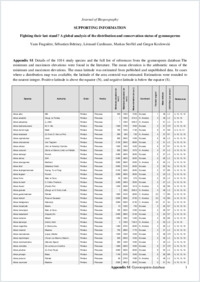Fighting their last stand? A global analysis of the distribution and conservation status of gymnosperms
- Fragnière, Yann Natural History Museum Fribourg, Switzerland
- Bétrisey, Sébastien Department of Biology and Botanic Garden, University of Fribourg, Switzerland - Conservation Biogeography, Department of Geosciences, University of Fribourg, Switzerland
- Cardinaux, Léonard Natural History Museum Fribourg, Switzerland
- Stoffel, Markus Dendrolab.ch, Institute of Geological Sciences, University of Bern, Switzerland - Institute for Environmental Sciences, Climatic Change and Climate Impacts, University of Geneva, Carouge, Switzerland
- Kozlowski, Gregor Natural History Museum Fribourg, Switzerland - Department of Biology and Botanic Garden, University of Fribourg, Switzerland
-
01.05.2015
Published in:
- Journal of Biogeography. - 2015, vol. 42, no. 5, p. 809–820
Angiosperm domination
conifers
cycads
Ginkgo
global diversity patterns
elevational distribution
gnetophytes
latitudinal distribution
latitudinal diversity gradient
English
Aim: Gymnosperms are often described as a marginal and threatened group, members of which tend to be out-competed by angiosperms and which therefore preferentially persist at higher latitudes and elevations. The aim of our synthesis was to test these statements by investigating the global latitudinal and elevational distribution of gymnosperms, as well as their conservation status, using all extant gymnosperm groups (cycads, gnetophytes, ginkgophytes and conifers).Location: Worldwide.Methods: We developed a database of 1014 species of gymnosperms containing latitudinal and elevational distribution data, as well as their global conservation status, as described in the literature. The 1014 species comprised 305 cycads, 101 gnetophytes, the only living representative of ginkgophytes, and 607 conifers. Generalized additive models, frequency histograms, kernel density estimations and distribution maps based on Takhtajan's floristic regions were used.Results: Although the diversity of gymnosperms decreases at equatorial latitudes, approximately 50% of the extant species occur primarily between the tropics. More than 43% of gymnosperms can occur at very low elevations (≤ 200 m a.s.l.). Gymnosperms, considering all species together as well as their main taxonomic groups separately, do not exhibit a latitudinal diversity gradient as commonly observed for many other taxa. Gymnosperms, and especially conifers, are on average less threatened at higher and equatorial latitudes.Main conclusions: Gymnosperms display an unusual latitudinal diversity gradient, which we suggest cannot fully be accounted for by angiosperm dominance and competitive superiority. We hypothesize that other factors explain their present distribution, such as the development of centres of endemism in several regions and the adaptation of certain taxa to cold and arid climates.
- Faculty
- Faculté des sciences et de médecine
- Department
- Département de Biologie
- Language
-
- English
- Classification
- Biological sciences
- License
-
License undefined
- Identifiers
-
- RERO DOC 257054
- DOI 10.1111/jbi.12480
- Persistent URL
- https://folia.unifr.ch/unifr/documents/304583
Other files
Statistics
Document views: 120
File downloads:
- pdf: 453
- Supplementary material: 278

